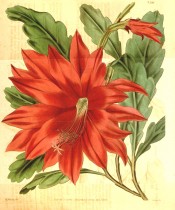Epiphyllum ackermanii Haw.
Frost tender, erect, perennial cactus with strap-like, flat, thin, scalloped, fleshy stems, sometimes 3-ribbed, freely branching from the base, and crimson or orange-red flowers with pale yellow-green tubes, to 12cm long, in summer. To 45cm. [RHSE, Hortus].
Horticultural & Botanical History
‘This splendid plant is a native of Mexico, whence a part of a stem was brought by Mr. George Ackermann, in compliment to whom the species has been named by Mr. Haworth.. The original stem was given to Mr. Tate, in whose Nursery it flowered in June of last year. […] This is a most desirable species, excelling in brilliance of colouring even the well-known C. speciosissimus.’ [BR f.1331/1830].
‘Mr. Murray received this truly splendid plant from Mr. Hitchin, with the remark, that it was raised from seeds which came direct from Mexico: thus confirming the statement of Mr. Tate, with regard to its native country (as given in the Bot. Register) which had been called in question. An opinion seemed to prevail that it was a seedling hybrid: and, indeed, it is an extraordinary circumstance, that a phyllanthoid Cactus should bear flowers as large, and almost exactly like those of Cereus speciosissimus. I have referred to the present species, though, certainly, not without hesitation, the Cereus oxypetalus of De Candolle above quoted, and those who will be at the trouble of comparing the two will find many striking points of resemblance; added to which they are both from the same country. Almost the only difference is in the flowers of C. oxypetalus being less spreading, “reddish-brown on the outside, and white within.” But when we consider that Professor De Candolle’s knowledge of the plant is solely derived from a Mexican drawing, we may be allowed to suppose that there probably exists some variation in the plant itself, or that the artist was not a faithful colourist. The sharpness of the petals, especially in the state of the bud, is very remarkable in both. With us it bears its magnificent flowers in June.’ [BM t.3598/1837].
Introduced to Britain in 1829. [JD].
History at Camden Park
This plant was listed in the catalogues as Cereus akermannius in 1843 and 1845, and as Epiphyllum Akermanni in 1850 and 1857 [T.412/1850]. Presumably William Macarthur adopted the revised generic name Epiphyllum prior to the printing of the 1850 catalogue. Still growing in the gardens.
Notes
Published Mar 05, 2009 - 04:41 PM | Last updated Jul 15, 2010 - 05:20 PM
| Family | Cactaceae |
|---|---|
| Category | |
| Region of origin | Probably of hybrid origin. Mexico. |
| Synonyms |
|
| Common Name | |
| Name in the Camden Park Record | Cereus Akermanius Epiphyllum Akermanni |
| Confidence level | high |


